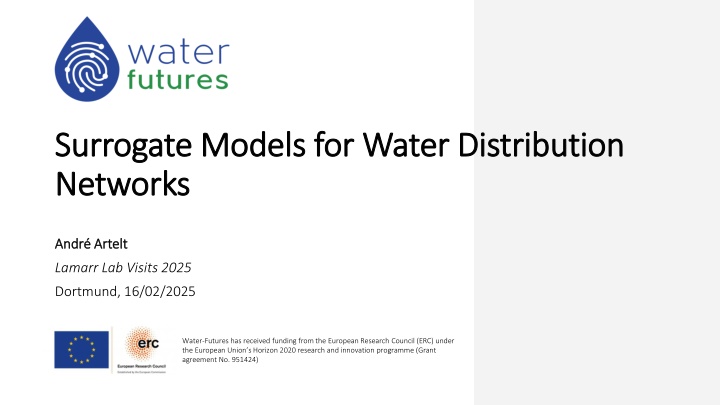
Enhancing Water Distribution Networks with Surrogate Models
Explore the application of surrogate models in water distribution networks to address challenges such as complex dynamics, uncertainties, and long-term planning. Learn about the need for neural surrogates in enhancing control, sensitivity analysis, and trustworthiness in critical infrastructures. Dive into hydraulic dynamics, modeling, and the iterative approach to estimating flows, demands, and pressures in water distribution systems.
Uploaded on | 2 Views
Download Presentation

Please find below an Image/Link to download the presentation.
The content on the website is provided AS IS for your information and personal use only. It may not be sold, licensed, or shared on other websites without obtaining consent from the author. If you encounter any issues during the download, it is possible that the publisher has removed the file from their server.
You are allowed to download the files provided on this website for personal or commercial use, subject to the condition that they are used lawfully. All files are the property of their respective owners.
The content on the website is provided AS IS for your information and personal use only. It may not be sold, licensed, or shared on other websites without obtaining consent from the author.
E N D
Presentation Transcript
Surrogate Models for Water Distribution Surrogate Models for Water Distribution Networks Networks Andr Andr Artelt Artelt Lamarr Lab Visits 2025 Dortmund, 16/02/2025 Water-Futures has received funding from the European Research Council (ERC) under the European Union s Horizon 2020 research and innovation programme (Grant agreement No. 951424)
Water Distribution Networks (WDNs) Water Distribution Networks (WDNs) Networks Networks for delivering drinking water to consumers => Critical Infrastructure Complex (sparse) Complex (sparse) spatio spatio- -temporal signals signals o Changes in demand o Events (leakages, sensor faults, contaminations, ...) o Uncertainties Tasks: Tasks: o Control o Event diagnosis o Planning o .. temporal
Modeling of Water Distribution Networks Modeling of Water Distribution Networks Modeled as a graph Dynamics Dynamics: oHydraulics oChemicals (i.e. water quality) Dynamics described by algebraic and (partial) differential equation and (partial) differential equations Simulation = Solving equations oSoftware such as EPANET-(MSX) oEPyT-Flow o . graph algebraic
Need of Surrogate Models Need of Surrogate Models Solvers are Solvers are oSlow oNot differentiable Neural Surrogates Neural Surrogates could enhance: oPlanning o(Model-based) Control oSensitivity analysis (e.g. sensor placements) Challenges: Challenges: oComplex dynamics oLong time horizons oTanks, pumps, valves oUncertainties oCritical domain => Trustworthiness?
Hydraulic Dynamics in WDNs Hydraulic Dynamics in WDNs Key quantities: Key quantities: oFlow oPressure (Head) oDemand Demand => Pressure & Flow Physics Physics oSteady-state (assumption) oConversation of flows oConversation of energy
Surrogate for Hydraulic Dynamics Surrogate for Hydraulic Dynamics Given a WDN graph Map demands to flows Map demands to flows and pressures and pressures Iterative Approach: oEstimate flows oReconstruct demands oEstimate heads, demands, flows in physics-informed message passing Algo. => Converges to fix point! Ashraf et al. 2024; Ashraf & Artelt et al. 2025
Water Quality Dynamics Water Quality Dynamics Key quantity Key quantity oChemical concentrations Challenge Challenge: Different chemicals & reactions => Lots of uncertainties! => No steady-state Physics Physics: oFlow => Concentrations oTransport, Mixing, and reactions oCurrent work: Benchmarks GNN for advective transport
Summary Summary Water Distribution Networks oGraphs oComplex dynamics Challenges oSparse spatio-temporal signals oUncertainties Hydraulics Surrogates Water Quality Surrogates Software packages on GitHub
